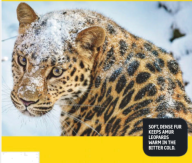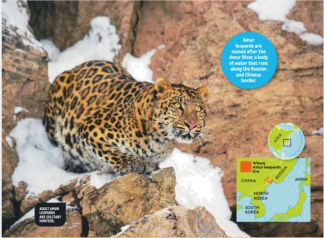My husband and I live near San Luis Obispo, California, close to the beach. In November 2023, during the humpback whale migration, we kayaked (划皮划艇) out to watch the wildlife. We were in awe watching these graceful whales breach and spray through their blowholes.
At the time, my friend Liz was staying with us. Initially, she refused to join us on the water, fearing the kayak would overturn among the whales. After some cajoling (劝说) she finally agreed to join me. The following morning, we set out early and had our first whale sighting just past the pier: two humpbacks swimming toward us. How amazing to be that close to a creature that size, I thought as the whales dipped under the waterline.
When whales go down after breaching, they leave what looks like an oil slick on the water. I figured if we paddled toward that spot, we’d be safe from the whales, since they’d just left. We followed them at a distance — or what I thought was a distance. I later found out that it’s recommended to keep 300 feet away. We were more like 60 feet away.
Suddenly, we were surrounded by jumping silverfish fleeing from the whales. Before we could react, our kayak was lifted out of the water about six feet, bracketed by massive jaws. Liz and I slipped out of the kayak into the whale’s mouth. As the whale’s mouth closed, I felt the creature begin to dive and had no idea how deep we’d be dragged. Still, I didn’t panic. I just kept thinking. I’ve got to fight this. I’ve got to breathe.
Whales have enormous mouths but tiny throats. Anything they can’t swallow they spit right out. That included us. As soon as the whale dipped underwater, it ejected us, and we popped back up onto the surface about a foot apart. The entire ordeal lasted only about 10 seconds.
Other kayakers rushed to our aid, shocked to see us alive. But I am much more aware of the power of nature and the ocean than I was before. Liz was shaken up, comparing the ordeal to a near-death experience, and she says her whale-watching days are over. But even she had to laugh when she got home that afternoon and realized she’d brought back a souvenir. When she pulled off her shirt, six silverfish flopped out.
【小题1】Which of the following statements is TRUE according to the passage?| A.At first, Liz was hesitant to go on the kayaking trip because she was not interested in whale watching. |
| B.If Liz and I had maintained a distance of 300 feet from the whales, we might have avoided the subsequent danger. |
| C.Liz and I slipped into the whale’s mouth because jumping silverfish overturned our kayak. |
| D.Liz is likely to go on another whale-watching trip someday because she found a precious souvenir from this kayaking. |
| A.Terrified and panicked. | B.Disoriented underwater |
| C.Calm and focused. | D.Regretful about going kayaking. |
| A.a challenging or difficult experience | B.a thrilling experience |
| C.a surprising encounter | D.a joyful adventure |
| A.How to Survive a Whale Attack | B.Respecting the Power of Nature |
| C.A Day at San Luis Obispo Beach | D.I Survived Being Swallowed By a Whale |
From lettuces (生菜) farmed on New York’s skyline to thick corridors of trees occupying Colombian roadsides, green initiatives are running wild in cities around the world.
Replanting initiatives have sprung up since the start of the 21st century as urban development goals have shifted and alarm about global warming has grown.
In nine cities around the world, thanks to planting schemes on walls and roofs, the temperature can be reduced by 3.6 to 11.3 degrees Celsius (摄氏的) at the hottest time of day, according to a report by the French Agency for Ecological Transition. Green spaces have also been shown to improve health and well-being, including by reducing stress, anxiety and depression, improving attention and focus, bettering physical health, said Stephanie Merchant of Bath University’s department for health. “However, it’s about where they are created in relation to the needs of the local communities,” she added.
So, are all urban replanting projects worthwhile?
“For a scheme to be seen as effective, it must fulfill as many functions as possible,” said the economist and urban planner Jean Haentjens. In addition to lowering the temperature, he said it should also preserve biodiversity, improve well-being, raise awareness, be appealing to residents and suitable for its social context.
The Brooklyn Grange rooftop farm in New York grows more than 45 tonnes of organic produce a year. Covering three rooftops, totalling more than 22,000 square metres, the farm cultivates a wide variety of vegetables. But it has to limit the soil depth to about 30 centimeters and irrigate (灌溉) the soil a little more frequently, because it dries out very quickly. Another question is whether pesticides (杀虫剂), which scare off birds and insects, are used when the aim is to boost biodiversity. For Jean Haentjen, it represents “an interesting route”, depending on the context. “But we can’t make it the model of tomorrow,” he said.
【小题1】What contributes to the popularity of green initiatives?| A.Global warming. | B.Improving attention. |
| C.Reducing stress. | D.Preserving biodiversity. |
| A.The characteristics of planting schemes. | B.The evaluation of urban replanting projects. |
| C.The classification of green initiatives. | D.The benefits of replanting initiatives. |
| A.Dissatisfied. | B.Cautious. | C.Indifferent. | D.Approving. |
| A.To tell readers the approach to global warming. |
| B.To inform people of the green initiatives worldwide. |
| C.To appeal to people to take part in the replanting initiatives. |
| D.To show the advantages and disadvantage of the planting schemes. |
THE WORLD’S RAREST LEOPARD
THESE BIG CATS GET A NEW CHANCE AT SURVIVAL.

Slowly stalking down the snowy hillside, the Amur leopard watches its prey through the trees. In the clearing below, a sika deer munches on tree bark, one of its few remaining food sources during the cold Russian winter. The leopard crouches, its body so low to the ground that its belly fur brushes the snow. Suddenly it bounds and springs forward, tackling the deer from 10 feet away. With a deadly combination of speed, strength, and stealth, the Amur leopard seems like it has everything it needs for survival. But not long ago — after decades of habitat loss and poaching — these endangered cats almost went extinct. Thanks in part to a newly established national park, however, Amur leopards are clawing their way back from the brink.
Disappearing Act

Most people think of leopards prowling African savannas, but the spotted predators are found in many different countries and habitats. They’ve adjusted to life in grasslands, jungles, deserts, and freezing, hilly landscapes. It’s there — along the Russian-Chinese border — that Amur leopards live, adapting to their chilly climate with bushier fur and longer legs to trudge through the deep snow.
Although Amur leopards thrive in freezing temperatures, by the late 20th century the human population moving into their habitat shrunk their California-size range by a huge 98 percent, trapping the animals in a stretch of land less than half the size of Puerto Rico. Poachers roamed the space that remained, killing the cats to sell their coats. In 2000, conservationists were stunned when a new count of Amur leopards estimated that only 30 were left in the world (though it was based on a study done by counting tracks, which isn’t the most reliable method). “These animals were going extinct,” biologist Dale Miquelle says. “Some of us were afraid it was too late to save them.”
Their solution? A new national park dedicated to protecting the endangered cat. But first, scientists had to convince the government that this was something worth doing — and that it could be done.
【小题1】In paragraph 1, the Amur Leopard will be almost extinct because ________.| A.the sika deer had moved their habitat to snowy hillside |
| B.human have hunted the leopard for decade |
| C.they can’t endure the chilly cold environment |
| D.the national park established |
| A.The leopards. | B.Human beings. | C.The poachers. | D.Leopards’ nature enemies. |
| A.It’s too late to save them. |
| B.They should convince the government to get human far from the habitat. |
| C.They should hurry to establish a national park. |
| D.They should let the government legislate to stop poaching. |
Domestic animals have often been known to save their human companions from danger. From the quick thinking of Duke, the dog who warned his guardians of their baby’s need for medical attention, to the smart actions of service dog Yolanda, who rescued her highly near-sighted human from a house fire by dialing 911, there are many animals out there who have earned the lasting gratitude of their human friends. However, it is truly surprising to hear about undomesticated(未驯服的) animals who, without any obvious reason, stepped in and saved humans from the coming death.
In June 2005, a twelve-year-old girl was caught by four men in rural south-west Ethiopia as she made her way home from school. A week after the kidnapping, her captors were trying to move her, when three lions chased the men off. The lions remained with the terrified girl until police officers arrived to send her to safety. She told them that although she had been beaten by her kidnappers, who it is believed had been attempting to sell her into a forced marriage, the lions had not touched her.
Sergeant Wondmu Wedaj said, “They stood guard until we found her and then they just left her like a gift and went back into the forest. Everyone thinks this is some kind of miracle, because normally the lions would attack people.” An Ethiopian wildlife expert claimed that the lions may have spared the girl because her cries had sounded like the mewing of a cub(幼兽).
This unbelievable story shows that, contrary to certain popular knowledge of wild animals as threats who must be removed to make way for human advancement, we have much more in common with non-human animals and are a lot more dependent on them than we realize. They, too, are capable of showing pity. They, too, have been known to step in and save those weaker than themselves at the most unexpected times, and in ways that humans often fail to predict. They, too, deserve to live out their lives on their own terms.
【小题1】Which of the following statements is true?| A.The little girl was forced to marry the kidnapper. |
| B.Wild animals often save humans for they’re weaker. |
| C.Wild animals are often regarded as threats. |
| D.The lion gave the girl to the police as a gift. |
| A.the lions frightened the kidnappers away |
| B.she frightened the kidnappers away with her cries |
| C.the police caught the kidnappers |
| D.the kidnappers freed her halfway |
| A.wild animals deserve a place on the earth |
| B.humans sometimes gain reward from wild animals |
| C.humans know wild animals can sometimes save them in need |
| D.it is wise for wild animals to be friendly to humans |
组卷网是一个信息分享及获取的平台,不能确保所有知识产权权属清晰,如您发现相关试题侵犯您的合法权益,请联系组卷网


